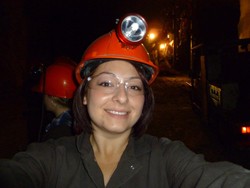Carla Dickson

1st Class Honours
B.Sc. (Honours) Thesis
Structural Geology of the Bear River Formation (Halifax Group) and White Rock Formation (Rockville Notch Group) Contact in the Cape St. Marys Area, Southwest Nova Scotia
(PDF - 16.8 Mb)
The contact between the Bear River Formation (BRF) (Halifax Group) and White Rock Formation (WRF) (Rockville Notch Group) at Cape St. Mary’s (CSM) is deformed at greenschist facies, but the exact nature of the contact is disputed. At the CSM “unconformity” cleavage in the BRF and WRF are parallel; and bedding in the WRF is parallel to the steeply SE-dipping contact and cleavage. Bedding in the BRF slate is more steeply dipping than the contact and displays asymmetric folds with the orientation of thickened short limb and thinned long limb, consistent with topside-up shear (SE, WRF side). The deformed folds are accompanied by intense cleavage with down-dip stretching lineation (quartz fringes on pyrite). With increased distance across strike NW from the contact the zone of intense cleave is replaced by a narrow interval of open folding bound by another zone of intense cleavage. In all zones of BRF, intersection of bedding and cleavage has subhorizontal to moderately steep plunge, suggesting heterogeneous deformation and the close angle between So/Sx1 fabric and the Sx2 fabric imply the rocks have experienced a high strain. No crenulation fabric was observed in the study area, however crenulations have been observed further southeast within the Cape St. Marys Shear Zone. No evidence of a discrete fault was observed at or near to the contact, therefore deformation was continuous across the contact and the units were deformed in-situ.
Vertical Arenicolites paired burrows in the intensely cleaved BRF slate function as paleo-plumblines with respect to bedding. Burrows are now boudined down-dip parallel to the quartz fringe lineation and lie within the Sx2 cleavage; the WRF dacite contains down-dip stretched lapilli also within the Sx2 cleavage, therefore there has been extension in the down-dip direction of the Sx2 cleavage plane. The burrows lie approximately 10o to bedding indicating a high degree of shear strain associated with the transposed bedding. The BRF slate also contains rigid pyrite crystals that disturbed the stress field and flow pattern around them during deformation. Slides of the pyrites normal to the minimum compression are low strain areas within which quartz strain fringes formed in the direction of the instantaneous stretching axis (ISA). The strain fringes are important not only because they produced the macroscopic down-dip lineation but also recorded part of the progressive deformation history of the host-rock and indicate the degree of non-coaxiality of deformation and the finite strain.
The interpretations of this thesis lead to the overall conclusion that the Bear River Formation and the White Rock Formation deformed in-situ and did so by White Rock Formation side-up plane strain simple shear across the region, where the direction of shear has been interpreted from sheared folds.
Keywords:
Pages: 95
Supervisor: Nicholas Culshaw



